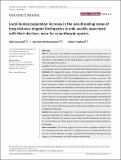Local human population increase in the non-breeding areas of long-distance migrant bird species is only weakly associated with their declines, even for synanthropic species
Abstract
Aim : To show how recent declines in populations of long-distance migrant birds are associated with recent increases in human population growth and agricultural intensification on their tropical non-breeding grounds, except for synanthropic species, where we expect the reverse. Location : Breeding populations throughout Europe and North America spending the non-breeding season throughout Africa, and Central and South America, respectively. Methods : We mapped 50 species of long-distance migrant birds from published tagging studies of 126 breeding populations and identified their breeding population trends from 2000-2015 from published Country or State census data. We then matched individual bird non-breeding locations, from each population, to local human population change and crop yield data. We used GLMs to predict whether bird population decline was associated with human population change or crop yield and whether this was dependent on if a species was synanthropic or not, controlling for absolute human population density, breeding and non-breeding location, migratory distance and phylogeny. We predicted that bird populations that spend the non-breeding season in areas of recent higher human population increase or agricultural intensification (crop yield), would show greater declines, but that declines would be less for species that frequently utilize anthropogenic habitats such as secondary woodland and farmland. Results : Bird population change, even for synanthropic species, showed a significant negative relationship with relative human population change and crop yield (but this was weak, <2% and 6% of variance respectively), and this relationship was the same for the Neotropics and Africa, despite African human population change being three times larger. Main conclusions : The results suggest that local human population change in the non-breeding area is likely to be only a relatively minor driver of migrant declines, and its effects may be through increases in agricultural intensification reducing carrying capacity but we currently lack local studies to confirm this.
Citation
Cresswell , W , Winifred , N & Patchett , R B 2019 , ' Local human population increase in the non-breeding areas of long-distance migrant bird species is only weakly associated with their declines, even for synanthropic species ' , Diversity and Distributions , vol. Early View . https://doi.org/10.1111/ddi.13006
Publication
Diversity and Distributions
Status
Peer reviewed
ISSN
1366-9516Type
Journal article
Collections
Items in the St Andrews Research Repository are protected by copyright, with all rights reserved, unless otherwise indicated.

